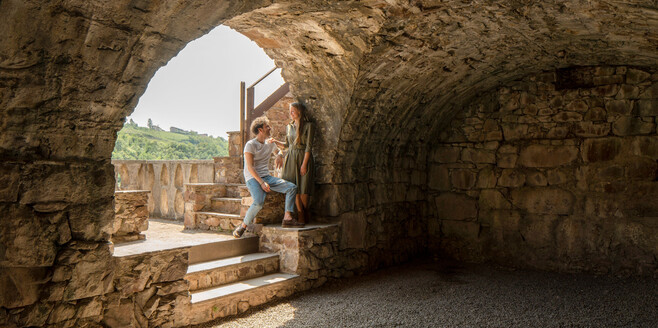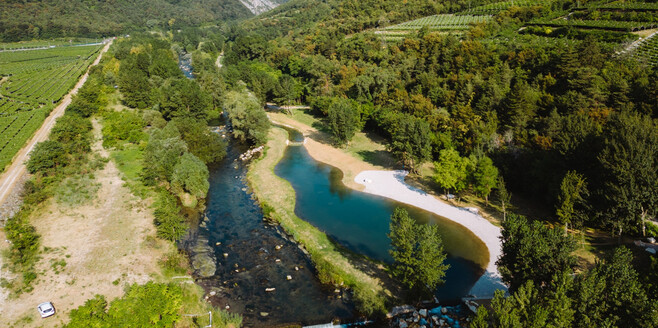Lesser-known cultural sites
Four days in Trentino, discovering some of its lesser-known gems steeped in history and culture
- 4 days
- April, May, June, July, August, September, October
- Art and Culture
Trentino, a land of history, art and nature, has fascinating and mysterious treasure troves of culture tucked away among its mountains, where they are known to few. These hidden gems reveal the authentic, genuine story of the land, enhanced by a thrilling sense of discovery.
Four destinations, with four stories, to be visited in four days, as you travel at a leisurely pace across Piana Rotaliana, Val di Non, Val di Sole and the Paganella Plateau.
Day 1: Piana Rotaliana - the astonishing story of Zambana Vecchia and its church





The Church of St Filippo and Giacomo, at the entrance to Val Manara, was built around 1539 over the ruins of a previous church dating from 1300.
In 1956, the church and the entire village of Zambana itself risked being lost as the result of a landslide. In the wake of this dramatic event, the zone was declared uninhabitable and a new village was built: Zambana Nuova, where two immense boulders sit in the piazza in memory of the incident. Later, thanks to consolidation and reconstruction works, Zambana Vecchia was declared geologically safe. The old and new settlements, Zambana Vecchia and Zambana Nuova, are now connected by the modern Arcobaleno bridge on the Noce river. If you pay a visit to this charming place, remember to take the time to admire the many extraordinary details of the church in Zambana Vecchia, like the phrase on the sundial, still shrouded in a veil of mystery.
Day 2: The Paganella Plateau - the little Church of St Thomas and the Via Imperiale





The little Gothic church of St Thomas, which dates back to the mid-1300s, can be found in the old part of Cavedago, at an altitude of 900 metres in highly scenic location. The steeply sloping roof features a bell tower with a Ghibelline spire. Inside, there are many 14th-century frescoes and a striking wooden altarpiece depicting the doubt of St Thomas, by the sculptor Egidio Petri of Segonzano.
Another interesting feature is the apse: covered by an umbrella vault, it boasts the signature of the master builder, Rocco de Redis, visible at the top of the back wall.
The Via Imperiale also passes by this site: a trail that retraces part of the route of the ancient road that linked the world of Germany-Tyrol to Italy, as an alternative to Valle dell'Adige.
Day 3: Val di Non – the Hermitage of Santa Giustina and the Bell Tower of Tregiovo





Even now, the origins of this site remain unknown. Legend has it that during the 10th century, it was inhabited by a monk called Secondo from Trento, before becoming a destination for pilgrimages over the years and, eventually, being abandoned. This magical place is built into a natural cave on the eastern side of the Santa Giustina Canyon, where the ancient walls of the ruined building blend in so well they are almost indistinguishable. The gorge is also a Trentino Nature Reserve, a protected haven where flora and fauna can live in safety.
Just half an hour away by car, the lonely Bell Tower of Tregiovo is also worth a visit. If you look up, over the rooftops of the village homes, you will catch a glimpse of a bell tower all alone on a hilltop, almost hidden in a little forest. Its history reveals a lot to us about how the people of the mountain once lived, and how important the tolling bells were for the community.
Day 4: Val di Sole – the artistic Church of San Valentino in Malè





The church of San Valentino has truly ancient origins. It was mentioned for the first time in a will from 1348, since when it has undergone many alterations and transformations. Inside is an altarpiece depicting Saint Valentine, attributed to the Vermiglio painter Domenico Del Pero. Visitors can get there by car or on foot along the road that runs through the village of Bolentina, not far from Malè. If you keep going along the dirt trail, at an altitude of around 1,300 metres, it’s possible to enjoy a panoramic view of Val di Sole and Val di Rabbi. The walk continues on to Malga Bassa di Bolentina and, finally, Malga Alta di Bolentina, at an altitude of no less than 1,822 metres.

